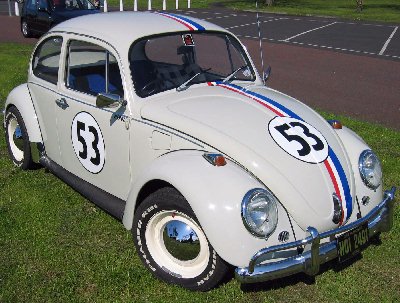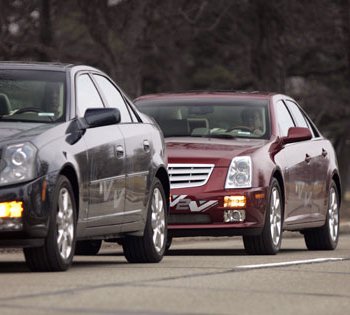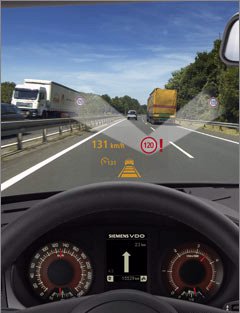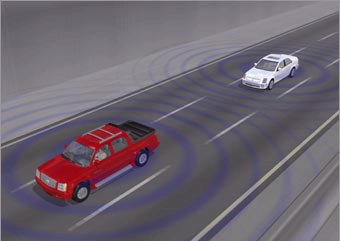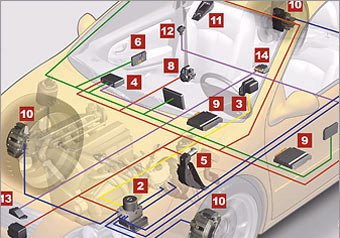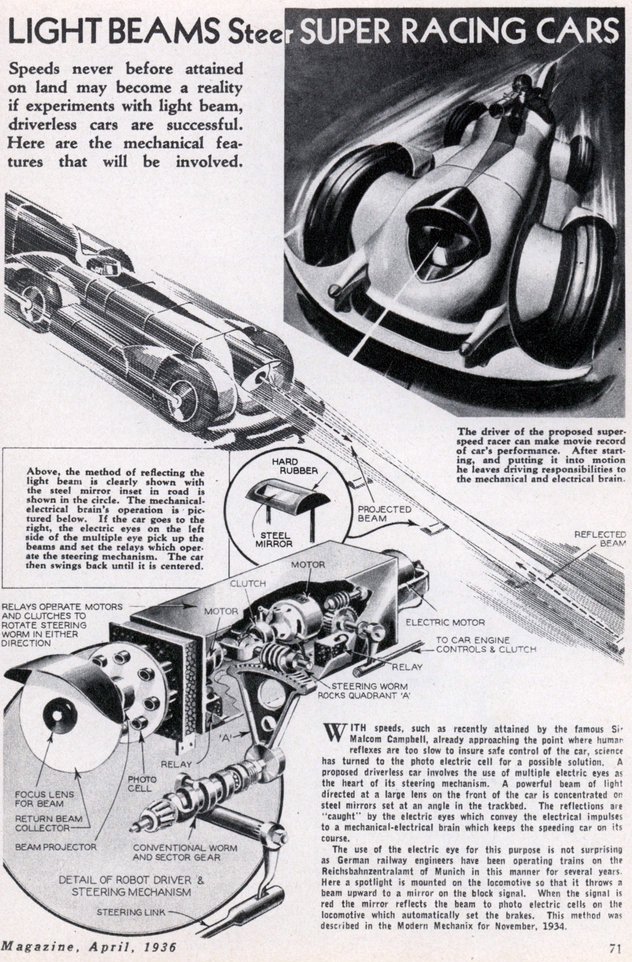|
|
|||||||||||||||||||||||||||||||
|
The GPS Self-Driving Car
Self-Driving Car no longer Science FictionIn the future cars will drive themselves and even park themselves at their destination. General Motors might start selling GPS cars by 2018. We've been looking forward to this technology for 50+ years, but now that it is finally only a decade away and GM is testing prototypes it is all a little... unbelievable. "Herbie the Lovebug", the original driverless car, was only a fantasy. Ten years from now we could be driving our own Herbies (or rather it would be driving us). General Motors is abuzz with the goal of being the first company to offer driverless cars. GM, parts suppliers, university engineers and other automakers are all working on vehicles that could revolutionize short- and long-distance travel. GM chief executive Rick Wagoner will devote part of his speech to the driverless vehicles tomorrow at the Consumer Electronics Show in Las Vegas. "This is not science fiction," Larry Burns, GM's vice president for research and development, said recently. The most significant obstacles facing the vehicles could be human rather than technical: government regulation, liability laws, privacy concerns and people's passion for the automobile and the control it gives them. Much of the technology already exists for vehicles to take the wheel: radar-based cruise control, motion sensors, lane-change warning devices, electronic stability control and satellite-based digital mapping. And automated vehicles could dramatically improve life on the road, reducing crashes and congestion.
But only if people are interested: "Now the question is what does society want to do with it?'' Burns said. "You're looking at these issues of congestion, safety, energy and emissions. Technically there should be no reason why we can't transfer to a totally different world.'' GM plans to use an inexpensive computer chip and an antenna to link vehicles equipped with driverless technologies. The first use likely would be on highways; people would have the option to choose a driverless mode while they still would control the vehicle on local streets, Burns said. He said the company plans to test driverless car technology by 2015 and have cars on the road around 2018. Sebastian Thrun, co-leader of the Stanford University team that finished second among six teams completing a 100-kilometre Pentagon-sponsored race of driverless cars in November, said GM's goal is technically attainable. But he said he wasn't confident cars would appear in showrooms within a decade. "There's some very fundamental, basic regulations in the way of that vision in many countries," said Thrun, a professor of computer science and electrical engineering. The defence department contest, which initially involved 35 teams, showed the technology isn't ready for prime time. One team was eliminated after its vehicle nearly charged into a building, while another vehicle mysteriously pulled into a house's carport and parked itself. Thrun said a key benefit of the technology eventually will be safer roads and reducing the roughly 42,000 U.S. traffic deaths that occur annually – 95 per cent of which he said are caused by human mistakes. "We might be able to cut those numbers down by a factor of 50 per cent," Thrun said. "Just imagine all the funerals that won't take place." Other challenges include updating vehicle codes and figuring out who would be liable in a crash and how to cope with blown tires or obstacles in the road. But the systems could be developed to tell motorists about road conditions, warn of crashes or stopped vehicles ahead and prevent collisions in intersections. Later versions of driverless technology could reduce jams by directing vehicles to space themselves close together, almost as if they were cars in a train, and maximize the use of space on a freeway, he said. "It will really change society, very much like the transition from a horse to a car," Thrun said. The U.S. government has pushed technology to help drivers avoid crashes, most notably electronic stability controls that help prevent rollovers. The systems are required on new passenger vehicles starting with the 2012 model year. Vehicle-to-vehicle communication and technology, allowing cars to talk with highway systems, could come next. Still in debate are how to address drivers' privacy, whether current vehicles can be retrofitted and how many vehicles would be needing the systems to develop an effective network. "Where it shakes out remains to be seen but there is no question we see a lot of potential there," said Rae Tyson, a spokesperson for the National Highway Traffic Safety Administration.
Driverless cars by 2018?The outlook: General Motors Corp. says that within the next 10 years it should be able to produce a car that drives itself. Other car companies and parts suppliers are working on similar systems. How they might work: The plan is to use an inexpensive computer chip and an antenna to link vehicles equipped with radar-based cruise control, lane-change warning devices, electronic stability control, satellite global positioning systems and digital maps. Possible effects: Such a system could prevent crashes and reduce congestion. Government regulations, liability laws and privacy concerns would need to be addressed. Sensors: It knows what it's doing Even the simplest car today can be filled with electronic sensors that monitor everything the car does from one fraction of a second to the next. Some monitors check how far the wheels are moving when you turn while others see what the car itself is doing when the wheels turn - if there's a mismatch, that's a problem. Sensors in the brakes time each spin of each of the car's wheels. If you hit the brakes and a wheel slows down more quickly than it should, that's a sign your brakes are locking up and the sensors trigger the anti-lock brakes to start pumping to regain traction. Other sensors will lay dormant for years, probably the entire life of your car, waiting for an impact that may never come. But if that impact ever does come, they'll trigger the airbags. There are monitors watching your behavior as well. They watch how far and how hard you press the gas and how far you're turning the wheel.
Radar: It knows what's out there While it's still usually found in luxury cars, radar is appearing in some less-espensive cars, too. The most common application is in back-up sensors. They simply warn you, as you're parking the car, when you're getting too close to something (or someone) behind you. Active cruise control is also becoming more common. These systems allow you to set a maximum speed for your car and will then maintain a set distance behind slower cars ahead. That way you don't have to turn the cruise control off every time you're behind a slowpoke. Most of these systems only work at highway speeds. But some, like the system created by Continental Tevis for the Mercedes-Benz S-class, actually work all the way down to a dead stop. If you're stuck in stop-and-go traffic, you need never touch the brakes or gas. The car does it all for you. When the traffic clears, off you go. The safety benefit of these systems is that they prevent a common cause of crashes - tailgating. Even if they don't do the driving for you, radar systems are also the bases for collision warning systems, like in the new Lexus LS, that watch the road ahead and warn the driver of an impending collision. Cameras: It can see and read On some more expensive luxury vehicles, cameras keep an eye on lane lines. If the car starts to cross over a line when the driver hasn't used a turn signal, an alarm sounds. The trick with using cameras to assist drivers is that the cameras have to know what to look for. Lane lines are fairly simple. Some companies are developing systems that can read the numbers on speed limits signs so they can warn you if you're going too fast. The Benz S-class uses an infrared camera and infrared light source to provide "night vision" capacity. The scene in front of the car is displayed in the center of the dashboard in green-and-black. Still, all of these are aids to seeing. The driver still makes the final choice about whether to cross a lane marker or exceed the speed limit.
Computers: It can decide what to do All that data being pumped out by all those sensors gets channeled to computers that calculate what the car should be doing at all times, given what the driver is doing with the steering wheel, gas and brake pedals. (In most modern cars, this data is also fed to a recorder that "remembers" several seconds worth of data and holds on to what it remembers in the event of a collision. That stored data can be used by accident investigators.) If the computer senses that the car is doing something that doesn't match - say one or two wheels are spinning too fast or the car isn't following the curve it should - the computer sends commands to actuators (basically tiny motors) that handle brakes, the throttle and possibly even steering mechanisms. For now, all these computers do is make sure the car is doing what the driver is telling it to do. Ultimately, preventing a crash is still the driver's responsibility. Communication: It can talk to others Many cars today have so-called "telematics" systems, such as General Motors' OnStar, that allow the driver to communicate with people or computers in remote locations. These systems can be accessed either by pressing a button or automatically in the event of a crash. Cars with these systems or with on-board navigation systems also have global position (or GPS) systems installed. GPS uses satellites to assess the exact location of a car. Several car companies are now working on systems that will allow cars to communicate directly with one another, passing information back-and-forth about each vehicle's position and speed. Data produced by sensors attached to the stability control and anti-lock-brake systems could instantly relay data about when a car is stopping - or not stopping - instantly warning other cars about potential hazards ahead. Drivers: What are we here for? When cars can know where they are, where they need to go, can steer and brake, can see lane markers and can instantly alert one another to their actions, the question arises: "What are drivers for?" With all but a small fraction of crashes caused by human error, a system of driverless cars will be much safer than anything possible with humans at the wheel. Computer-driven cars also hold the promise of higher speeds and lower fuel consumption. Streams of cars networked together could travel down major highways at a single high rate of speed without the risk of hitting each other. In cities, it has been estimated that intersections could handle hundreds of times as many cars as they do know with none of the cars ever needing to stop. Travelling at steady speeds uses less fuel than accelerating and decelerating for stop signs or bottlenecks. Also, with the risk of collision greatly reduced, cars would need less extra weight, in the form of airbags and steel, dedicated to occupant protection. Fully self-driving cars are possible on our current roadways using technology that could be in place in as little as a decade, said Larry Burns, General Motors' vice president for research and development. Many barriers to the driverless car are social rather than techinical. There are privacy issues. Many drivers are already uncomfortable with "event data recorders" in most new cars that record everything a car was doing immediately before an impact. What will the reaction be to cars that continuously broadcast everything a car does? There are also issues of trust. Some drivers will always put ultimate faith in their own driving skillls no matter what. And many will simply miss the pleasure of driving a car. With concerns rising over "distracted driving," however, it's clear that most people would rather be doing something else while they're behind wheel. "We've concluded that, for a lot of people, driving has become the distraction," said Burns.
Blast from the Past:LIGHT BEAMS Steer SUPER RACING CARS Speeds never before attained on land may become a reality if experiments with light beam, driverless cars are successful. Here are the mechanical features that will be involved. With speeds, such as recently attained by the famous Sir Malcom Campbell, already approaching the point where human reflexes are too slow to insure safe control of the car, science has turned to the photo electric cell for a possible solution. A proposed driverless car involves the use of multiple electric eyes as the heart of its steering mechanism. A powerful beam of light directed at a large lens on the front of the car is concentrated on steel mirrors set at an angle in the trackbed. The reflections are “caught” by the electric eyes which convey the electrical impulses to a mechanical-electrical brain which keeps the speeding car on its course. The use of the electric eye for this purpose is not surprising as German railway engineers have been operating trains on the Reichsbahnzentralamt of Munich in this manner for several years-Here a spotlight is mounted on the locomotive so that it throws a beam upward to a mirror on the block signal. When the signal is red the mirror reflects the beam to photo electric cells on the locomotive which automatically set the brakes. This method was described in the Modern Mechanix for November, 1934.
|
|
||||||||||||||||||||||||||||||
|
Website Design + SEO by designSEO.ca ~ Owned + Edited by Suzanne MacNevin | |||||||||||||||||||||||||||||||
